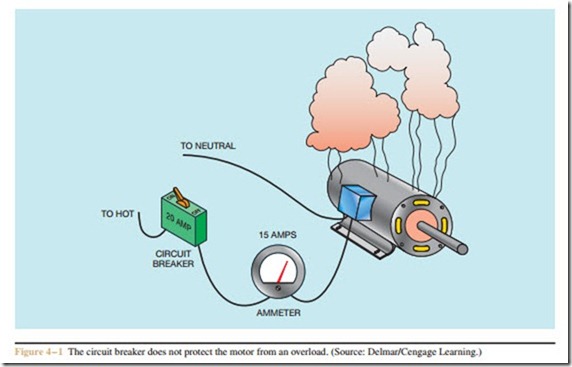Overloads
Overloads should not be confused with fuses or circuit breakers. Fuses and circuit breakers are designed to protect the circuit from a direct ground or short-circuit condition. Overloads are designed to protect the motor from an overload condition. Assume, for example, that a motor has a full load current rating of 10 amperes. Also assume that the motor is connected to a circuit that is protected by a 20 ampere circuit breaker, Figure 4 – 1. Now assume that the motor becomes overloaded and has a current draw of 15 amperes. The motor is drawing 150% of full load current. This much of an overload will overheat the motor and damage the windings. But, since the current is only 15 amperes, the 20 ampere circuit breaker will not open the circuit to protect the motor. Overload relays are designed to open the circuit when the current becomes 115% to 125% of the motor full load current. The setting of the overload is dependent on the properties of the motor that is to be protected.
Overload Properties
There are certain properties that all overload relays must possess in order to protect a motor:
1. They must have some means of sensing motor current. Some overload relays do this by converting motor current into a proportionate amount of heat, and others sense motor current by the strength of a magnetic field.
2. They must have some type of time delay. Motors typically have a current draw of 300% to 800% of motor full load current when they start. Motor starting current is referred to as locked rotor current. Since overload relays are generally set to trip at 115% to 125% of full load motor current, the motor could never start if the overload relay tripped instantaneously.
3. They are divided into two separate sections: the current sensing section and the contact section. The current sensing section is connected in series
with the motor and senses the amount of motor current. This section is typically connected to volt- ages that range from 120 volts to 600 volts. The contact section is part of the control circuit and operates at the control circuit voltage. Control circuit voltages generally range from 24 volts to 120 volts, although some controls operate on line voltages of 240 or 480 volts.
